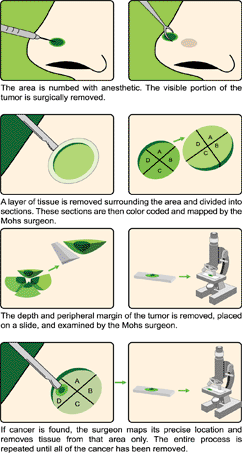Answering Questions About Mohs Micrographic Surgery
Dr. Fredrick Mohs developed Mohs surgery as a precise method of treating skin cancers. This pioneering procedure combines surgical removal of cancerous tissue with microscopic examination and immediate identification of the type of cancer a patient has.
While each patient is unique, Mohs surgery is typically deemed appropriate in four scenarios:
When a tumor develops in an area of the body where it is not effectively curable by other methods.
- When a tumor is located on a part of the body such as the nose, eye, ear or lip and it is desirable to save as much normal tissue as possible.
- When a previously-treated cancer has returned.
- When the margin or the extent of a tumor cannot be easily defined.
- What is the advantage of Mohs surgery over other treatments?
With a 99% success rate, Mohs surgery is the most effective skin cancer treatment available. The procedure creates the smallest possible defect. Therefore, allowing for the best possible cosmetic result.
Because tumors that are not well defined can blend into the normal skin tone or scar tissue from previous surgeries, Mohs surgeons do not rely solely on surface inspection for evaluation of the extent of cancer. Instead, we carefully trace the extent of the tumor before removing diseased tissue, and therefore decrease the possibility of missing cancerous cells or needlessly removing healthy skin.
Mohs procedures are considered minor surgeries and are normally performed on an outpatient basis at the doctor’s office. Although the procedure typically takes three to five hours, patients should be prepared to spend the entire day if necessary.
The surgery is usually performed in stages, with each stage taking approximately 15 minutes to one hour. The stages include the removal of the cancerous tissue and reconfirmation of complete removal of the tissue. Keep in mind that the number of stages required varies with each patient and is determined by the size and depth of the cancer.

Be sure to eat a full, healthy meal and bring reading material if you like. You may bring a snack if you wish; because you will have waiting periods between surgical stages.
You are encouraged to wear comfortable clothing. You should wear a shirt which buttons down the front if you are having surgery on your torso. Avoid wearing white.
Please continue to take all of your prescribed medications prior to surgery. Consult your physician before stopping any medications. Because they promote bleeding, refrain from the use of medications such as Plavix, Motrin, Ibuprofen, asprin, Advil, Naprosyn, and Vitamin E at least one week before surgery. We Do Not request you stop Coumadin for any skin surgical procedure at our facility.
If you routinely receive antibiotic prophylaxis prior to dental or surgical procedures, be sure to ask for it prior to your Mohs Surgery. This is usually the case with patients who have history of heart valve disease, patients who were born with heart abnormalities, or those who have had knee or hip replacement.
Also, avoid alcoholic beverages one week before surgery.
For more information about The Skin Surgery Center of Houston or for skin cancer treatment information please call (713) 984-0010.
